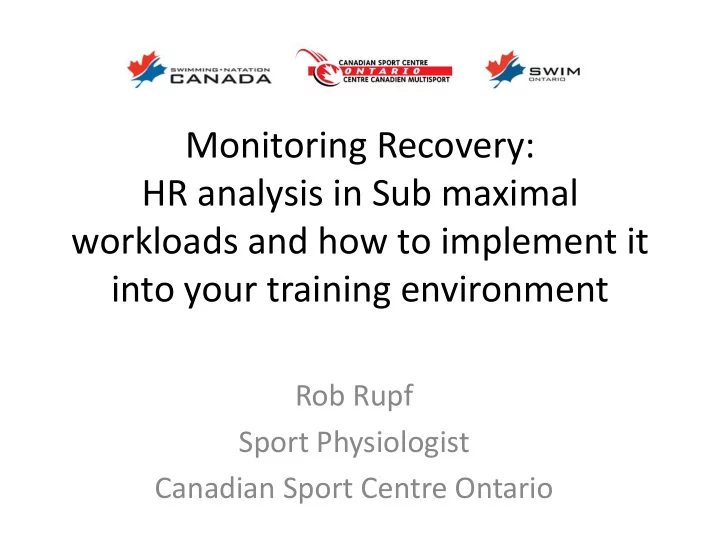

Monitoring Recovery: HR analysis in Sub maximal workloads and how to implement it into your training environment Rob Rupf Sport Physiologist Canadian Sport Centre Ontario
Recovery • Is a critical process for programming in high volume sports • Monitoring recovery and having the ability to detect minute changes that can impact performance is critical to the ongoing development of the athlete.
Recovery • Things that need to be done – Nutrition – Sleep – Hydration • But how do we monitor recovery – Questionnaires – Heart Rate
Heart Rate • Heart rate and recovery – WHY? – Autonomic Nervous System • Role in exercise • Role in whole body control • Influenced by various stress hormones – Therefore can get an idea of stress placed on the body by measuring HR
Resting HR • Resting HR’s – Is a good place to start analyzing ANS. • Increased vagal tone or decreased sympathetic tone means lowered HR. • Increased sympathetic tone or decreased vagal tone means increased HR.
Resting HR and Training Performance
Potential Limitations of Resting HR • Other peripheral causes and cardiac adaptations can lead to increases in HR after initial adaptations • While this is great for short term ventures (ie training camps), longer term solutions may provide misleading information • Exercise may provide greater opportunities to provide longer term adaptations and determine health of recovery – Submaximal exercise may provide a better indication
Sub Maximal HR Monitoring Systems • Idea of using this monitoring system – Understand how that athlete will train during that session – Understand the metabolic costs of training – Ability to help predict their performance?? • This will give us more immediate feedback on each individual athlete. – Athlete specific – And it will help us know how the athlete is feeling right at that moment
Protocol • 2 X 200m on 4 minutes – One at an easy pace (50 beats below max HR) – One at a moderate pace (30 beats below max HR) • Incorporate this into the warm up • Plot the results
Right Shift – Good Response
Left Shift – Poor Response
Scenario 1 – Right Shift
Performance Increase
High Metabolic Cost?
Training Load Implications • Training Load hits the target zone • Increased cardiac load but similar lactate values shows greater efficiency in stroke mechanics???
Scenario 2 – Left Shift
They still can hold performance
Breakdown in Technique?? Disproportionate Increase in SR
Physiological Cost Disproportionate Increase in La and HR
Training Load Implications • Training times can be maintained. It will just hurt more. • Maintaining these times might produce higher than desired physiological loads. – This may be primarily due to breakdown in stroke technique
Sub Maximal Monitoring and Performance ??
Overview • Using HR can help determine changes in performance – Both resting and submaximal • Longer term chronic use of resting HR may be limited • Use of Submaximal testing may provide more sport specific information on loading – How much internal load that athlete will undergo? – Breakdown in stroke efficiency? – Prediction on future performance??
Questions ???
Recommend
More recommend